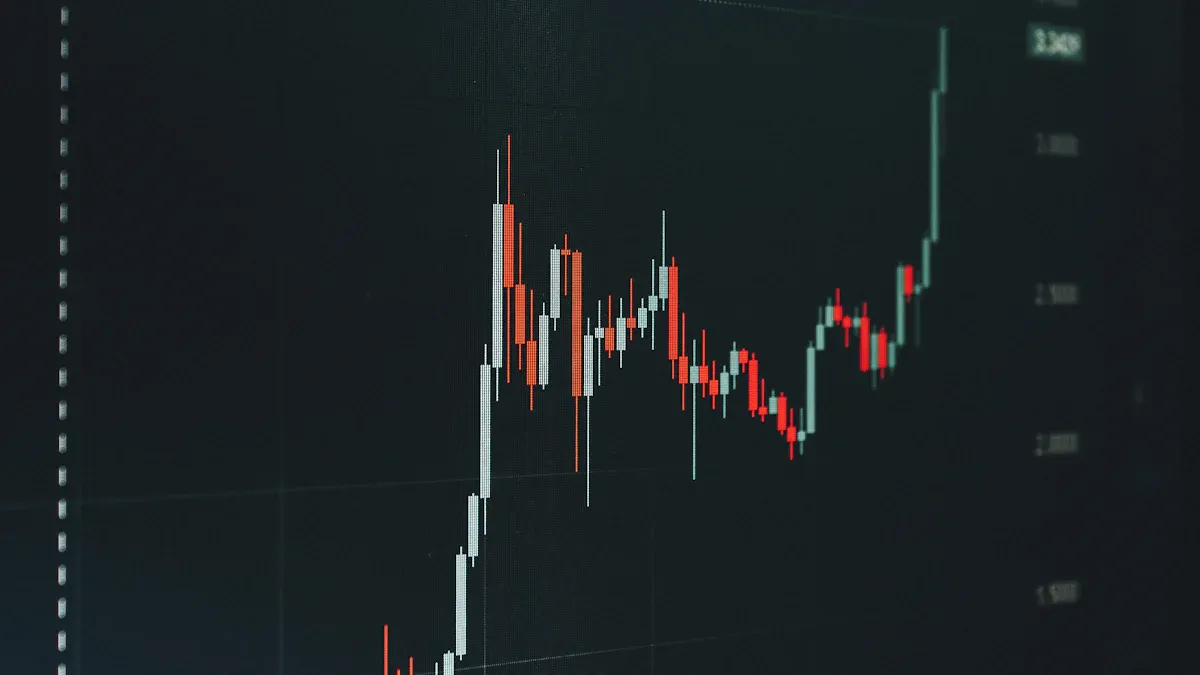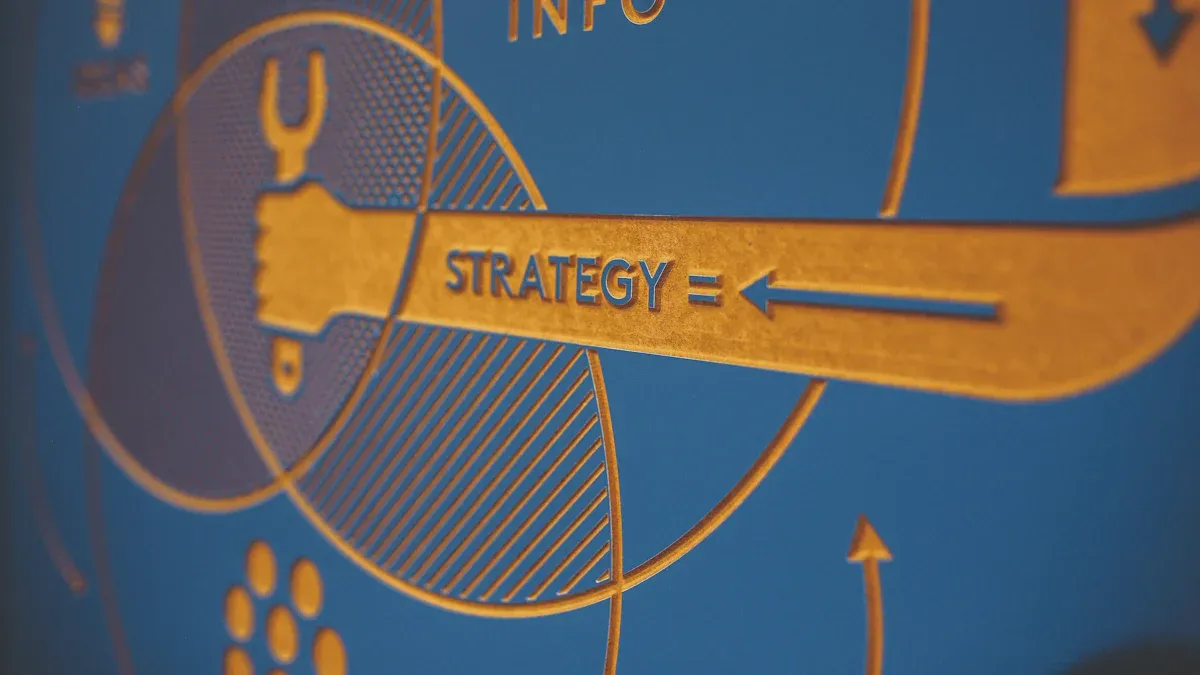- EasyCard
- Trade
- Help
- Announcement
- Academy
- SWIFT Code
- Iban Number
- Referral
- Customer Service
- Blog
- Creator
Why Profitable Traders Can’t Ignore In-the-Money Options?

Image Source: unsplash
Want to join the few who consistently profit in the market? Profitable traders often prioritize in-the-money (ITM) options due to their higher intrinsic value and stronger safety margin. You can use ITM options to control risk, enhance capital efficiency, and make every trade more reliable. Choosing the right tools can elevate your trading strategy, achieving controlled risk and stable profits.
Key Points
- ITM options provide a natural safety margin, helping you better control risk and protect capital.
- Choosing ITM options can boost win rates, as they’re more sensitive to small market movements.
- Leveraging ITM options allows you to achieve greater profit potential with less capital.
- Develop a detailed trading plan with clear risk and capital allocation to maintain rational trading.
- Avoid common pitfalls, such as not having a plan or ignoring market volatility, to improve trading performance.
Advantages of In-the-Money Options

Image Source: pexels
Risk Control
Your primary concern in trading is risk. In-the-money (ITM) options offer a natural safety margin because they already have intrinsic value, giving you a profit buffer upon purchase. In contrast, out-of-the-money (OTM) options lack intrinsic value, risking the entire premium paid. When you choose ITM options, even small market fluctuations are less likely to wipe out your capital.
Think of ITM options as “investments with a safety cushion.” Even if the market moves unfavorably, losses are partially offset by the intrinsic value.
In the U.S. market, many consistently profitable traders favor ITM options for their focus on capital preservation and long-term stability.
Higher Win Rates
Want to improve your trading win rate? ITM options are a strong choice. Their lower extrinsic value means you only need small movements in the underlying asset to profit.
-
In trading strategies, Probability of Profit (POP) refers to the chance of earning at least $0.01 by a specific date.
-
For long-term options, POP is typically lower than the probability of being ITM at expiration.
-
For short-term options, POP is often higher than the probability of being OTM at expiration.
-
ITM options have lower extrinsic value, requiring smaller underlying asset movements to achieve profitability.
You’ll find that profitable traders prefer ITM options to boost win rates. They don’t chase one-time windfalls but aim for high success rates per trade.
Leverage Effect
Want to maximize returns with less capital? ITM options can help. Although they have higher premiums, the capital required is far less than buying the underlying asset outright. You gain exposure similar to owning the asset with a fraction of the investment.
- ITM options typically have higher premiums due to their stronger profit potential.
- OTM options, while cheaper, carry higher risks, potentially losing the entire premium.
With ITM options, you achieve leverage while enjoying a higher safety margin, significantly boosting capital efficiency.
In the U.S. market, professional traders use ITM options to optimize capital allocation, balancing risk and reward.
Strategies of Profitable Traders
Strategy Breakdown
To achieve consistent long-term profits, you need a scientific trading strategy. Profitable traders often make ITM options a core tool because they enable effective risk management and enhance profit certainty across market conditions.
You can integrate ITM options into your trading process in these ways:
- Protective Put Options: When holding a stock, buy an ITM put option. If the market drops suddenly, the put limits losses while keeping your position protected.
- Covered Calls: While holding the underlying stock, sell ITM call options to earn premium income, generating returns even if the stock price fluctuates.
- Spread Trading: Simultaneously buy and sell options with different strike prices to create vertical, calendar, or diagonal spreads, locking in risk ranges and improving capital efficiency.
In practice, the intrinsic value of ITM options gives you confidence in trades. You don’t need large market swings to profit—small movements suffice. You can also control maximum losses, avoiding catastrophic setbacks from a single mistake. Profitable traders use these strategies to keep risk firmly in check.
When crafting a trading plan, prioritize ITM options. They provide a solid foundation for decisions, reducing emotional trading.
Case Study
Consider this U.S. market example to see how profitable traders use ITM options for consistent gains.
Suppose you’re bullish on a U.S. tech stock trading at USD 150. You plan to hold the stock but worry about short-term market volatility. You can use a protective put strategy:
- You buy 100 shares of the tech stock, costing USD 15,000.
- You purchase an ITM put option with a USD 145 strike price at USD 7 per share, costing USD 700 for 100 shares.
- If the stock drops to USD 140, your stock loss is USD 1,000, but the put option yields USD 500 (USD 145 - USD 140 = USD 5/share, 100 shares), limiting your total loss to USD 500.
This approach acts as “insurance” for your investment, protecting against sudden losses while allowing upside potential if the stock rises. Many profitable traders use this risk management technique.
You’ll also notice that professional traders at licensed Hong Kong banks use similar ITM option strategies when managing client assets. Through covered calls or spread trading, they generate steady cash flows while strictly controlling risk. These methods are standard among global professional traders.
To improve your trading performance, learn from these strategies and make ITM options a key tool for risk management and profit enhancement.
Risk Management

Image Source: pexels
Using Greeks
When trading ITM options, you must use Greeks to measure and manage risk. Greeks are critical risk metrics in options trading. The table below outlines their roles:
| Risk Metric | Description |
|---|---|
| Delta (Δ) | Measures option sensitivity to underlying asset price changes. |
| Theta (θ) | Measures option price change as expiration approaches. |
| Gamma (Γ) | Measures the rate of change in Delta with underlying price shifts. |
| Vega | Measures option price sensitivity to implied volatility changes. |
| Rho | Measures option price sensitivity to interest rate changes. |
In practice, ITM options have a Delta close to 1, making them highly sensitive to stock price changes. Theta is also significant, with time value decaying faster. You can use a Delta-neutral strategy, adjusting option and stock positions to achieve a net Delta of zero, stabilizing portfolio value during price swings. You can also employ Gamma scalping, frequently trading the underlying asset to profit from small price movements while maintaining Delta neutrality. Mastering Greeks is a critical step toward becoming a professional trader.
Discipline Control
When trading ITM options, strict discipline is essential. Set stop-loss and take-profit levels to avoid emotional decisions driven by market fluctuations. Create a detailed trading plan outlining risk and expected returns for each trade. Regularly review trades, analyzing successes and failures to refine strategies. Control position sizes to avoid over-concentration in a single asset. Discipline ensures consistent profitability over time.
View discipline as your trading “moat.” Each disciplined action strengthens your capital’s safety.
Handling Extreme Market Conditions
In extreme market conditions, you must adapt strategies flexibly. U.S. markets see sharp volatility spikes during major events or earnings seasons. Use a long straddle strategy to buy both call and put options when expecting high volatility, locking in potential gains. Alternatively, a long strangle reduces costs while offering flexibility. Combine diversified strategies to spread risk and minimize losses from one-sided moves.
- Long straddles are ideal before earnings reports or major events, with low cost and controlled risk.
- Long strangles suit strong price movement expectations with uncertain direction, offering high flexibility.
- Diversified strategies balance high and low volatility risks, reducing potential losses.
In extreme conditions, proactive planning and scientific management allow you to protect capital and even achieve outsized returns.
Lessons for Retail Traders
Selection Methods
When choosing ITM options, focus on key factors. First, understanding Greeks helps assess risk and reward. Monitor Delta, Theta, and other metrics to gauge sensitivity to price changes and time decay. Second, manage position sizes to limit risk exposure. Finally, track performance metrics like daily Delta exposure, Theta decay rates, and win-loss ratios to optimize decisions.
- Understand Greeks to evaluate risk and reward.
- Manage position sizes to control investment risk.
- Monitor performance metrics to refine decisions.
U.S. market data shows that in Nifty Index Put Option contracts, only ITM options outperform market prices. For Bank Nifty call options, short-term ITM and deeply ITM contracts are more likely to be overvalued, highlighting ITM options’ advantages in practice.
Trading Plan
When crafting a trading plan, define risk and capital allocation clearly. A detailed plan keeps you rational, avoiding impulsive decisions during market swings. Use only “comfortable” capital for trading to minimize emotional interference. Stick to predefined risk levels, avoiding impulsive increases due to short-term volatility.
- Create a detailed plan with clear risk and capital allocation.
- Trade only with “comfortable” capital to stay rational.
- Adhere to risk controls, avoiding unplanned increases.
Think of your trading plan as a “battle map.” Clear planning ensures steady progress in the market.
Avoiding Pitfalls
When using ITM options, avoid common mistakes. First, not having a trading plan leaves you directionless during volatility, increasing risk. Second, focusing solely on expiration charts may overlook current risk-reward ratios, leading to losses. Third, ignoring market volatility can skew judgments. Finally, understand the risk-reward relationship to make informed choices.
- No trading plan leads to emotional trading.
- Focusing only on expiration charts ignores current risk-reward ratios.
- Ignoring volatility affects decision-making.
- Not understanding risk-reward increases loss probability.
Continuous learning and reviewing trades help improve performance. Avoiding these pitfalls allows you to leverage ITM options for consistent profits.
To achieve consistent long-term profits, ITM options are indispensable. You can enhance performance by:
- Precisely calculating option premiums, profits, and losses to manage financial outcomes actively.
- Maintaining profitability by monitoring breakeven points and adjusting option sales.
- Regularly reassessing and calibrating strategies based on mathematical results and market conditions.
Profitable traders integrate these principles into their systems. You can incorporate ITM options into your strategy to improve risk management and win rates.
FAQ
What’s the difference between ITM and OTM options?
When you buy ITM options, they have intrinsic value. OTM options have only time value and no intrinsic value. ITM options are more likely to yield profits.
Why do professional traders prefer ITM options?
ITM options allow better risk control. You need only small underlying asset movements to profit. Professionals prioritize safety margins for consistent returns.
Are ITM options better for short-term or long-term trading?
You can use ITM options for both short- and long-term trading. Short-term, you lock in quick profits; long-term, you gain a higher safety margin.
What risks should you watch for when buying ITM options?
Monitor time value decay and underlying asset price fluctuations. Unfavorable price moves could result in losing the entire premium.
How significant is the leverage effect of ITM options?
ITM options let you achieve asset-like returns with less capital, boosting efficiency. Manage risks carefully to balance the leverage effect.
In options trading, in-the-money (ITM) options stand out as the preferred choice for consistently profitable traders due to their intrinsic value and enhanced safety margins, enabling better risk control and higher win rates. Yet, many traders encounter challenges in global markets, such as high cross-border remittance fees, exchange rate uncertainties, and platform reliability issues, which can erode profits or complicate executions.
BiyaPay serves as a reliable financial platform to address these pain points. We offer real-time exchange rate queries, allowing seamless checks on fiat and digital currency conversions across various currencies for transparent and efficient transactions. With remittance fees as low as 0.5%, spanning most countries worldwide and supporting same-day transfers, BiyaPay streamlines your fund movements. Moreover, without requiring an overseas account, you can engage in US and Hong Kong stock trading via our stocks feature, integrating ITM options strategies to boost potential returns. Sign up with BiyaPay now to elevate your options trading and achieve more consistent profits!
*This article is provided for general information purposes and does not constitute legal, tax or other professional advice from BiyaPay or its subsidiaries and its affiliates, and it is not intended as a substitute for obtaining advice from a financial advisor or any other professional.
We make no representations, warranties or warranties, express or implied, as to the accuracy, completeness or timeliness of the contents of this publication.




Contact Us
Company and Team
BiyaPay Products
Customer Services
is a broker-dealer registered with the U.S. Securities and Exchange Commission (SEC) (No.: 802-127417), member of the Financial Industry Regulatory Authority (FINRA) (CRD: 325027), member of the Securities Investor Protection Corporation (SIPC), and regulated by FINRA and SEC.
registered with the US Financial Crimes Enforcement Network (FinCEN), as a Money Services Business (MSB), registration number: 31000218637349, and regulated by FinCEN.
registered as Financial Service Provider (FSP number: FSP1007221) in New Zealand, and is a member of the Financial Dispute Resolution Scheme, a New Zealand independent dispute resolution service provider.



















